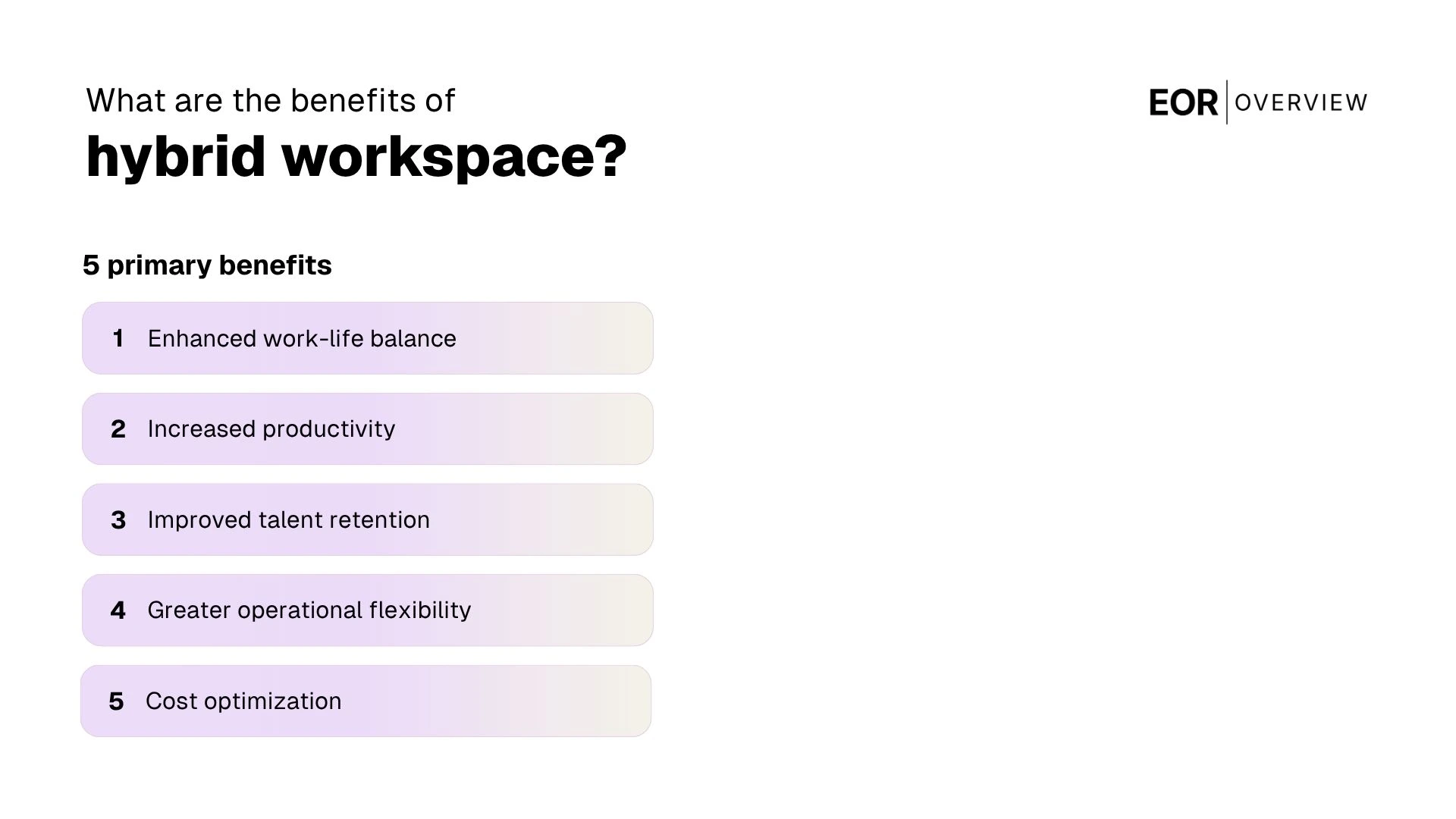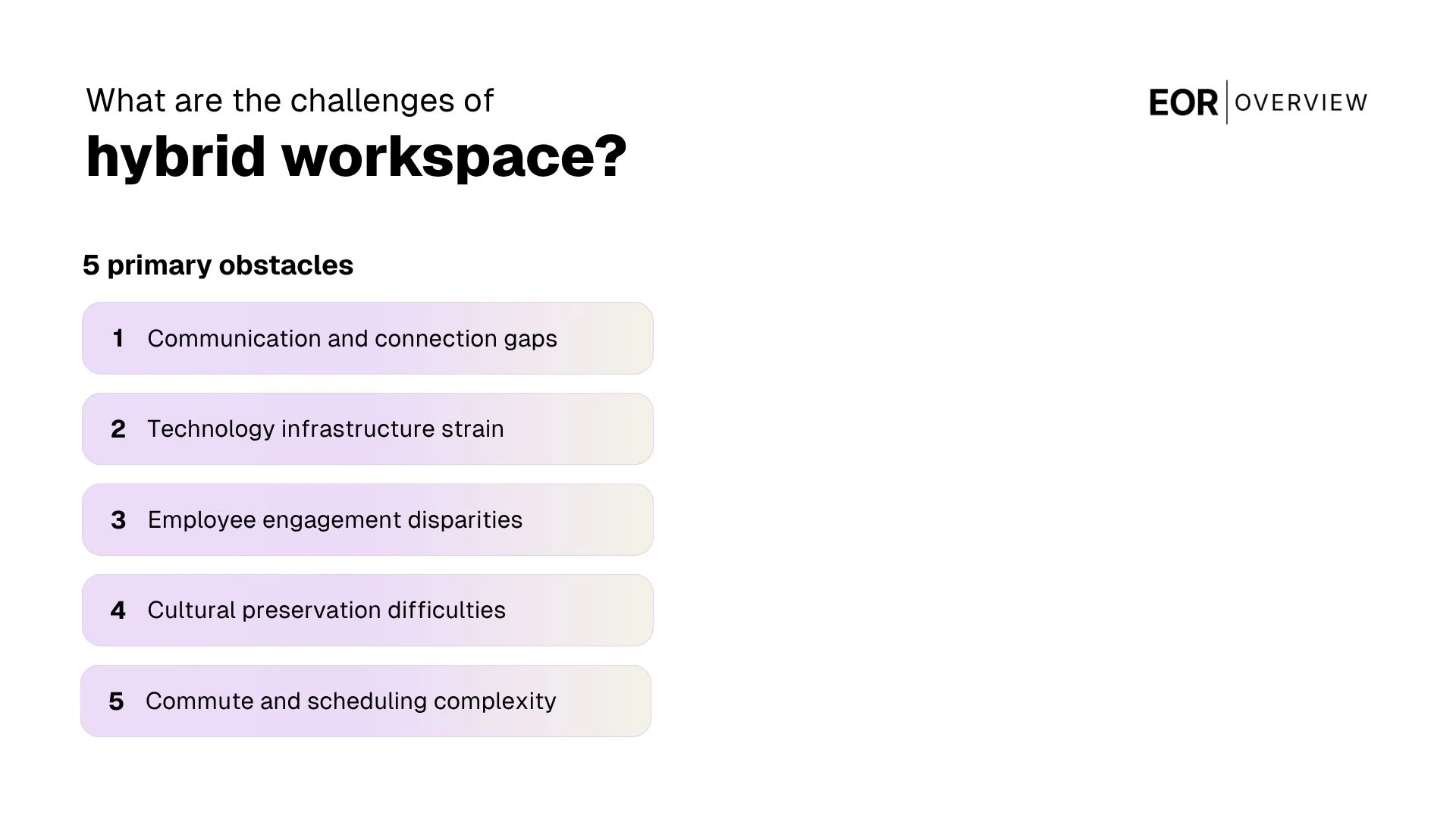A hybrid workspace is a flexible work arrangement that combines remote work with in-person office time, allowing employees to split their schedules between home and traditional office environments based on business needs and personal preferences.
For HR and hiring managers in tech, finance, and startup environments, hybrid workspaces have become essential for attracting skilled professionals who now expect flexibility as a standard benefit. This model addresses the growing demand for work-life balance while maintaining the collaborative advantages of in-person interaction. Companies implementing effective hybrid strategies gain a significant competitive edge in talent acquisition and retention.
Organizations that successfully implement hybrid work models report improved employee satisfaction and expanded access to talent pools beyond their immediate geographic location, making this approach particularly valuable for fast-growing companies competing for specialized skills.
What is hybrid workspace?
A hybrid workspace is a flexible work environment that seamlessly combines remote work and in-office collaboration, allowing employees to choose where they work most effectively. This hybrid workplace model has transformed how organizations approach productivity, employee satisfaction, and operational efficiency in the modern business landscape.
The hybrid work model enables teams to split their time between traditional office settings and remote locations, including work from home arrangements. Unlike fully remote or completely in-person structures, the hybrid workforce approach gives employees autonomy over their work environment while maintaining essential face-to-face collaboration opportunities.
For HR managers and hiring leaders, implementing a hybrid workplace strategy means redesigning policies, technology infrastructure, and management practices. The hybrid team structure requires new approaches to communication, performance measurement, and company culture maintenance that bridge physical and digital workspaces effectively.
This hybrid model represents the future of work, where organizations can attract top talent regardless of geographic location while reducing overhead costs and improving employee work-life balance through strategic workplace flexibility.

What are the benefits of hybrid workspace?
The hybrid workspace delivers significant advantages that transform how organizations operate and how employees experience their careers. These benefits include enhanced work-life balance, increased productivity, improved talent retention, greater flexibility, cost optimization, and stronger employee satisfaction. These benefits are listed in detail below.
Enhanced work-life balance: Team members can optimize their work hours around personal commitments, leading to a better work-life balance that reduces burnout and increases job satisfaction.
Increased productivity: Remote workers often demonstrate higher productivity levels when they can choose their optimal work environment, whether that's working remotely or collaborating in-person during key projects.
Improved talent retention: A successful hybrid workplace attracts top talent who value flexible work arrangements, helping organizations retain their best performers in competitive markets.
Greater operational flexibility: The workforce can adapt quickly to changing business needs, with remote employees maintaining continuity during disruptions while in-office collaboration continues when needed.
Cost optimization: Organizations reduce overhead expenses through smaller office footprints while maintaining the collaborative benefits of in-person teamwork for critical activities.
Focus on creating clear guidelines for when team members should be in-office versus remote. The most successful hybrid workplaces define specific collaboration days while allowing flexibility for individual work, making the transition smoother for both managers and employees.
The future of work increasingly depends on how well organizations can deliver an exceptional employee experience through hybrid models. Companies that master this balance position themselves as employers of choice in today's competitive talent landscape.

What are the challenges of hybrid workspace?
While hybrid workspace models offer flexibility that employees want, they create significant challenges for HR managers and leadership teams. The shift from traditional office environments requires careful navigation of communication gaps, technology limitations, and cultural preservation.
The primary obstacles include maintaining connection between remote and in-office teams, ensuring equitable access to opportunities, managing technology infrastructure, preserving company culture, and optimizing productivity across different work environments.
These challenges require strategic planning and targeted solutions to ensure hybrid employees remain productive and engaged. Understanding these obstacles helps organizations find the best approaches for their unique workforce needs.
Communication and connection gaps: Remote workers often struggle to feel connected to their in-office colleagues, leading to information silos and reduced collaboration during the workday.
Technology infrastructure strain: Organizations must invest in robust systems that support seamless collaboration between office space and remote locations, ensuring work gets done efficiently.
Employee engagement disparities: Maintaining consistent employee engagement becomes challenging when team members have different levels of face-to-face interaction and access to leadership.
Cultural preservation difficulties: Company culture traditionally built through daily interactions and spontaneous conversations faces erosion without intentional efforts to recreate these touchpoints.
Commute and scheduling complexity: Managing flexible commute schedules while ensuring adequate office coverage requires sophisticated planning and clear policies that evolved significantly post-COVID-19.
What are the types of hybrid work schedules?
Organizations implementing a hybrid work environment can choose from several schedule types that balance in-office and remote work based on their operational needs and employee preferences. Each approach offers unique advantages for different work styles and project management requirements.
The most effective hybrid work schedules include structured days, flexible arrangements, role-based models, and project-driven approaches. These best practices help organizations create a sustainable way of working while maintaining productivity and collaboration.
These hybrid work schedule types are listed in detail below.
Fixed hybrid schedule: Employees work specific days in the office and designated days remotely, creating predictable patterns that support team collaboration and individual focus time.
Flexible hybrid schedule: Team members choose their office days based on meetings, project needs, or personal preferences, offering maximum autonomy in their work style approach.
Role-based hybrid model: Different positions have customized hybrid or remote arrangements based on job requirements, with client-facing roles spending more time in the flexible workspace.
Project-driven schedule: Teams adjust their location based on current initiatives, gathering in-office for collaborative phases and working remotely during independent work periods.
Successfully transitioning to a hybrid work environment requires clear communication of expectations and consistent application of chosen scheduling models across departments.
What are the best practices for hybrid workplace?
The most effective hybrid workplace practices include flexible scheduling policies, redesigned office layouts, clear communication protocols, technology integration, performance measurement systems, and culture reinforcement strategies. These practices are listed in detail below.
Flexible scheduling policies: Establish clear guidelines for when employees work from home and the office, allowing teams to optimize their productivity based on task requirements and personal preferences.
Redesigned office layout: Transform traditional workspaces into collaboration hubs with flexible meeting spaces, hot-desking options, and technology-enabled areas that support both on-site and remote team members.
Clear communication protocols: Implement consistent communication standards that ensure all team members stay connected regardless of where they're working, using unified platforms and regular check-ins.
Technology integration: Deploy seamless digital tools that enable smooth transitions between home and office work, including cloud-based systems and video conferencing capabilities.
Performance measurement systems: Focus on outcomes rather than location, establishing clear metrics that evaluate productivity and results instead of hours spent in a specific workspace.
Culture reinforcement strategies: Regularly communicate the company's values through virtual and in-person activities, ensuring remote and on-site employees feel equally connected to organizational goals and maintaining high employee satisfaction levels.
How hybrid work has evolved?
The hybrid workspace has transformed dramatically since its emergency adoption during the pandemic. What began as a temporary solution for social distancing has evolved into a strategic approach that combines remote and in-person work environments. Organizations initially struggled to maintain productivity when employees split their time between working from home and the traditional office setting.
Early hybrid models often created challenges where work gets done in silos, with remote team members feeling disconnected from colleagues in the office. Companies quickly learned that simply alternating between fully remote days and office days wasn't enough to work effectively. The evolution required reimagining how teams collaborate across different locations and time zones.
Today's hybrid workspace prioritizes intentional in-person collaboration while recognizing that many employees are more productive at home than in the office for focused work. Organizations now design office spaces with fewer assigned desks and more collaborative areas, acknowledging that the physical workspace serves a different purpose than before.
Schedule anchor days when your entire team works in the office simultaneously. This ensures meaningful face-to-face interaction and prevents the fragmentation that occurs when hybrid schedules don't align.
What are the technologies you need to make hybrid work?
The right technology stack can make or break your hybrid workspace strategy. Cloud-based solutions form the foundation, giving employees seamless access to files and applications from anywhere. Video conferencing platforms like Zoom have become essential for maintaining face-to-face connections, while collaboration tools ensure your team stays productive whether they're working from the office or remotely.
Essential hybrid work technologies include communication platforms, project management systems, cloud storage solutions, and security tools. These technologies work together to offer remote flexibility while maintaining strong company culture and operational efficiency.
These technologies are listed in detail below.
Communication platforms: Video conferencing and instant messaging tools help reduce office isolation by keeping distributed teams connected and engaged throughout the day.
Cloud infrastructure: Cloud-based file storage and applications give your team the greater flexibility to work seamlessly from any location with proper internet access.
Collaboration software: Project management and document sharing platforms ensure workers can coordinate effectively regardless of their physical location.
Security solutions: VPN access and endpoint protection tools keep company data safe as employees move toward more flexible work arrangements.
Don't assume all employees have the same tech setup at home. Many remote workers feel isolated not just socially, but technologically when they lack proper equipment or reliable internet connections.
Companies moving toward hybrid models find that better equipped remote workers have a positive impact on overall productivity and recruitment efforts. This tech-forward approach serves as a valuable perk that helps attract top talent who want flexible work options.

